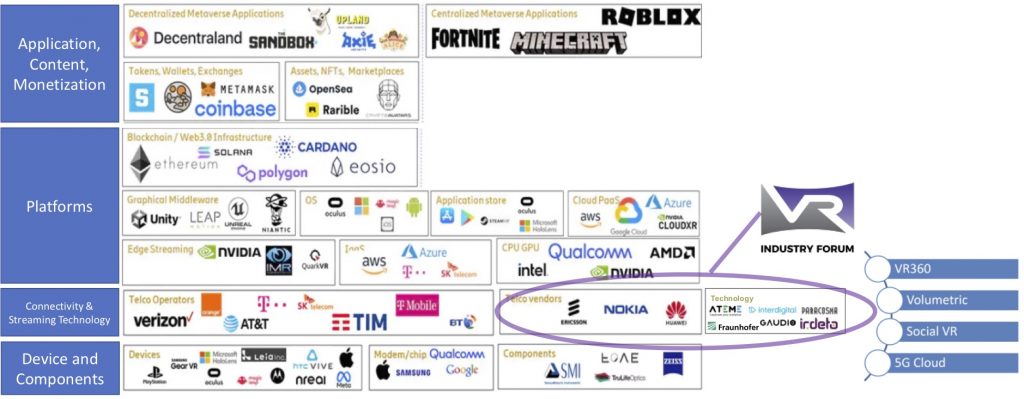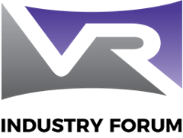Welcome to the VR Industry Forum Newsletter
Keeping you updated about our activities!
Here we highlight our latest work and focus on areas which are most critical.
A Message from the President
VRIF into the Metaverse Interop Madness
| Immersive technologies and XR devices are the gateway to interact with virtual worlds and metaverses. With more advance technology, the better is the interaction and user interface. A fundamental aspect of the metaverse is the social interaction between different users and the virtual worlds; thus, connectivity is key to transport the user to a virtual experience in real time. The Metaverse ecosystem is diverse and there are several stakeholders that address different parts of this ecosystem, ranging from applications, platforms, technology, devices, and connectivity providers. The figure below illustrates this ecosystem[1]. |
| Interoperability is not an easy task, since there are many formal standards, de facto industry standards, and proprietary solutions and services from different parts of the value chain that are trying to coexist. Just by looking at the figure, the first though that comes to our mind: this is an “interop madness”; to fix this, it requires a tremendous effort from the entire ecosystem to solve this issue. Since its inception, VRIF’s main goal has been to improve interoperability for immersive services (such as VR streaming). We only address a specific part of the metaverse ecosystem: areas such as media technology and connectivity, as described above, are fundamental parts of this interoperability madness. VRIF remain focused on its original vision, we think that our four parallel tracks: VR360, Volumetric, Social VR and 5G Cloud are essential for the success of Metaverse interoperability. Since we strive for a more open ecosystem, we are happy to announce that VRIF has joined the Metaverse Standards Forum as a participant member in an effort to continue our mission: “To further the widespread availability of high quality audiovisual VR experiences, for the benefit of consumers” Mauricio Aracena VRIF President |
| ________________________________ [1] Note that this ecosystem is for illustration purposes; it is not intended to be at all an exhaustive list. |
Updates on immersive video standardization in MPEG: A new Mesh Coding standard on the horizon
| Over the last years, ISO/IEC JTC1 SC29, also known as the Motion Picture Expert Group (MPEG), has been actively working on various compression standards for distribution of immersive visual data. These standards are collected in the Visual Volumetric Video-based Coding (V3C) family of standards and cover a variety of use cases: Compression of individual objects represented as 3D dynamic point clouds, Video-based Point Cloud Coding (V-PCC)Coding immersive scenery, known as MPEG Immersive Video (MIV)Carriage and delivery mechanisms for V3C coded data.And, most recently, compression of dynamic 3D mesh representations.While V-PCC, MIV and carriage of V3C data have already matured and been released as the ISO/IEC standards 23090-5, 23090-12, and 23090-10[2], respectively, the work for a new standard on dynamic mesh compression has just started. At the MPEG meeting in April 2022, several proposed solutions have been evaluated. And at the most recent MPEG meeting in July the starting point and software test model for the joint standardization activity has been agreed upon. Five companies have presented their solutions for dynamic mesh coding. Based on subjective and objective coding performance evaluation, one proposal has been selected as the basis for the collaborative standardization work. Based on the V3C framework, this proposal simplifies a 3D mesh first, before encoding the base mesh using known mesh coding solutions, such as Edgebreaker. Additional information, so-called displacement maps, is encoded as video streams and used at the decoder to reconstruct the original mesh fidelity from the simplified base mesh. Texture information is also coded as video streams and completes the codec design. Based on its heavy utilization of video-coding technology, the name for this new standard was decided as “Video-based dynamic mesh coding (V-DMC).” MPEG plans to finalize this new standard by the end of 2024. Overview articles on the other V3C standards can be found here: |
| ________________________________ [2] VRIF has released Volumetric Video Guidelines on these standards (https://www.vr-if.org/guidelines/). |
Welcome to our newest VRIF member: InterDigital!

| InterDigital is one of the world’s largest pure research, development, and licensing companies with a rich heritage in wireless and video technologies, including 5G. InterDigital designs and develops advanced technologies, often years ahead of market deployment, to enable and enhance mobile communications and unlock a new world of immersive engagement. InterDigital engineers have led the design and development of a wide range of innovations used throughout digital cellular and wireless networks, including 3G, 4G, 5G and beyond and IEEE 802-related products and networks, while maintaining a strong heritage of video innovation and standards leadership. In fact, InterDigital holds more than 70 leadership positions in critical wireless and video standards organizations like 3GPP, ITU, and MPEG. In the domain of XR, InterDigital video and wireless teams collaborate to advance the state-of-the-art in volumetric video, scene description, haptics, and interactivity, including advanced transport protocols and network architecture, to realize the emerging vision that will become the metaverse. Integral to laying the functional foundation for the devices and connected industries of tomorrow, InterDigital maintains one of the largest licensing programs in the world, with license agreements with 80 of the top global tech companies. Over the last decade, InterDigital technology has been licensed to more than 6 billion devices worldwide. |
Meet us at IBC 2022
VRIF members are participating in the IBC 2022 event.
|
VRIF Masterclass, Workshop and Face-to-Face Meetings
| We had our first F2F meeting (since the pandemic started) in Berlin, thanks to our host and VRIF member, Fraunhofer. We also participated in the Fokus Media Web Symposium in the same venue. You can see the recordings and presentation in the following links: VRIF Volumetric Guidelines Masterclass & Workshop (June) FOKUS MWS (June) |
If you’re not already a Member – Join Today!
Membership Information
The VRIF is an organization built by the VR community and maintained by it. As a valuable member of this community, we ask you to consider joining the VRIF organization. Yearly membership already starts at $1000. More details can be found on our website: https://www.vr-if.org/membership-benefits/
Some key member benefits:
- Contribute to the future of immersive video and drive the Guidelines by participating in our various Work Groups
- Define VRIF priorities
- Promote your leadership through speaking and other opportunities
- Network with industry experts
- Full access to MPEG standards and working documents
- Participate in interoperability testing with early access to guidelines, content and other tools
Many industry leaders already see the importance and value of VRIF. Join today and add your voice. We welcome your participation and look forward to meeting soon.

